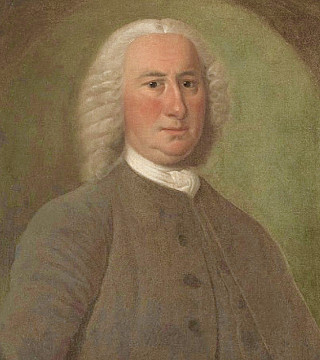Gabriel Manigault (1704-1781)
Merchant of Charleston; State Assemblyman & Treasurer of South Carolina
He was born at Charleston, South Carolina. He imported rum, wine, sugar, oils, fabrics and flour to sell at his shops on Tradd Street while exporting rice, naval stores, leather, beef and corn. He owned partnerships in several vessels and was the sole owner of a brigantine and two schooners. Although he was not enthusiastic about the slave trade and refused to lend money to slave traders, he did occasionally venture into the trade. He invested his profits into land and owned thousands of acres as well as 270-slaves to work his plantations at Silk Hope on the Cooper River, Seewee Barony and Salt Ponds. In 1734, he was appointed Public Treasurer for the Colony of South Carolina and represented St. Philip Parish in the Royal Assembly. He contributed generously to charity, giving £3,500 to help French immigrants, £5,000 to the South Carolina Society, and as President of the Charleston Library Society contributed rooms to house its collection.
Shortly after the Declaration of Independence, he loaned £652,500 to the government of South Carolina and although 75-years old when the British advanced on Charleston in May, 1779, he joined the lines of defence with his 15-year old grandson, Joseph. Nonetheless, when the British captured Charleston in 1780, he took the oath of allegiance to the King and retired to his plantation at Goose Creek. His generous loan and unimpeachable business reputation in the colony ensured that his estate was not confiscated by legislature after the war. In 1730, he married Anne, daughter of John Ashby, 2nd Cassique of Quenby Plantation in Berkeley County. He left a fortune of $800,000 that made him perhaps the richest merchant in South Carolina. He was survived by one son.
Shortly after the Declaration of Independence, he loaned £652,500 to the government of South Carolina and although 75-years old when the British advanced on Charleston in May, 1779, he joined the lines of defence with his 15-year old grandson, Joseph. Nonetheless, when the British captured Charleston in 1780, he took the oath of allegiance to the King and retired to his plantation at Goose Creek. His generous loan and unimpeachable business reputation in the colony ensured that his estate was not confiscated by legislature after the war. In 1730, he married Anne, daughter of John Ashby, 2nd Cassique of Quenby Plantation in Berkeley County. He left a fortune of $800,000 that made him perhaps the richest merchant in South Carolina. He was survived by one son.
Parents (2)
Categories
Share
Image Courtesy of the Metropolitan Museum of Art, Wiki Commons; The Huguenot Church in Charleston (2018)




